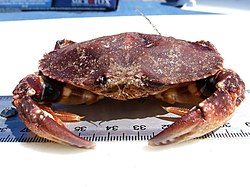| Metacarcinus gracilis | |
|---|---|
 | |
| Scientific classification | |
| Domain: | Eukaryota |
| Kingdom: | Animalia |
| Phylum: | Arthropoda |
| Class: | Malacostraca |
| Order: | Decapoda |
| Suborder: | Pleocyemata |
| Infraorder: | Brachyura |
| Family: | Cancridae |
| Genus: | Metacarcinus |
| Species: | M. gracilis |
| Binomial name | |
| Metacarcinus gracilis | |
| Synonyms [1] | |
Cancer gracilisDana, 1852 | |

The graceful rock crab or slender crab, Metacarcinus gracilis (the naming convention recognized by WoRMS) or Cancer gracilis (the naming convention recognized by ITIS), is one of two members of the genus Metacarcinus, with white tipped chelae (claws). The second crab in the genus to have white tipped claws is M. magister (Dungeness crab). [2] Both of these eastern Pacific crab species are recognized by ITIS as belonging to the much larger genus Cancer. M. gracilis has been caught from Alaska to Bahía Magdalena, Baja California Sur. [3] Although M. gracilis is only found in the Pacific Ocean, it has cousins in the Atlantic Ocean. The genus Cancer ( sensu lato ) apparently evolved in the Pacific Ocean and later migrated to the Atlantic Ocean. [4] Larvae and small juveniles of this species are often seen riding jellyfish, especially Phacellophora camtschatica . The juvenile crabs steal food from the jellyfish and also clean off parasitic amphipods. [5]